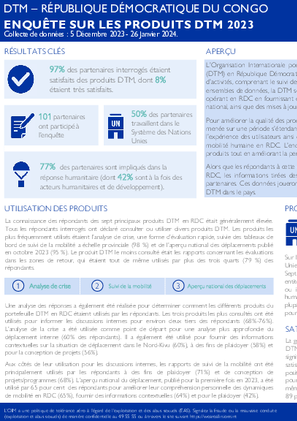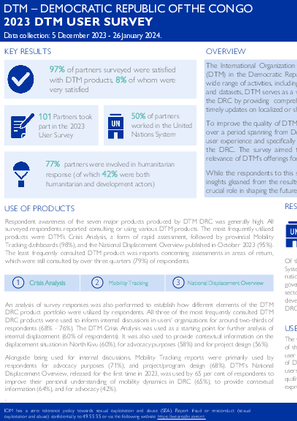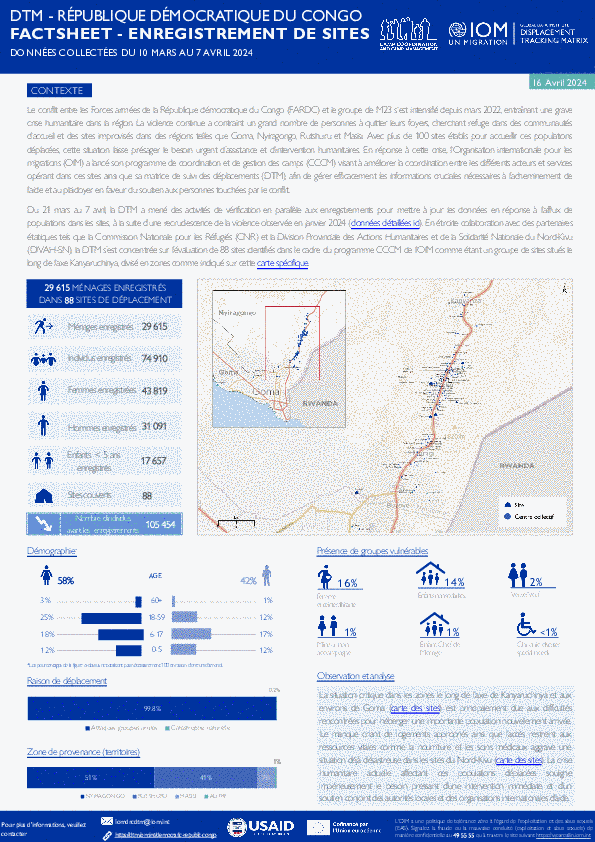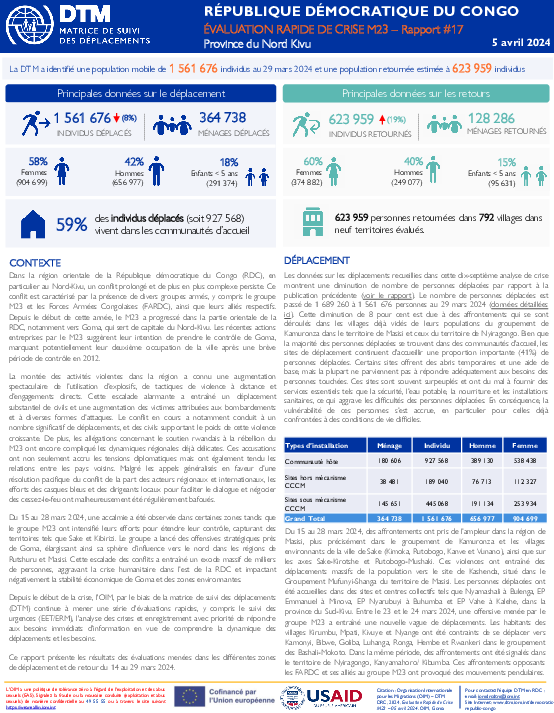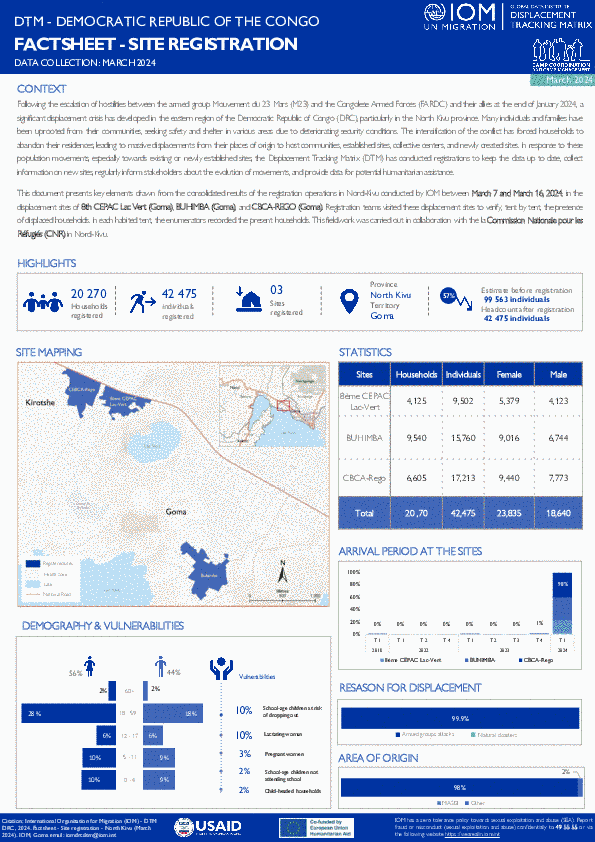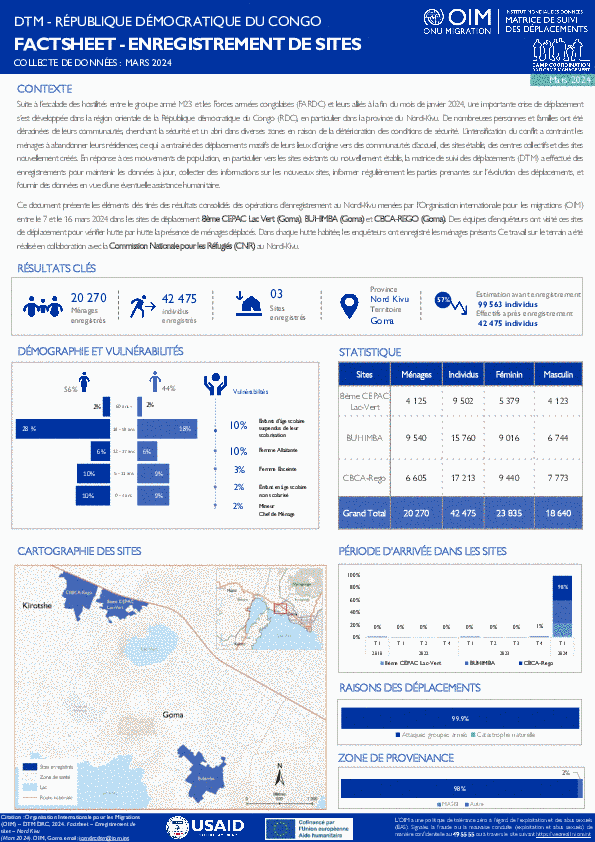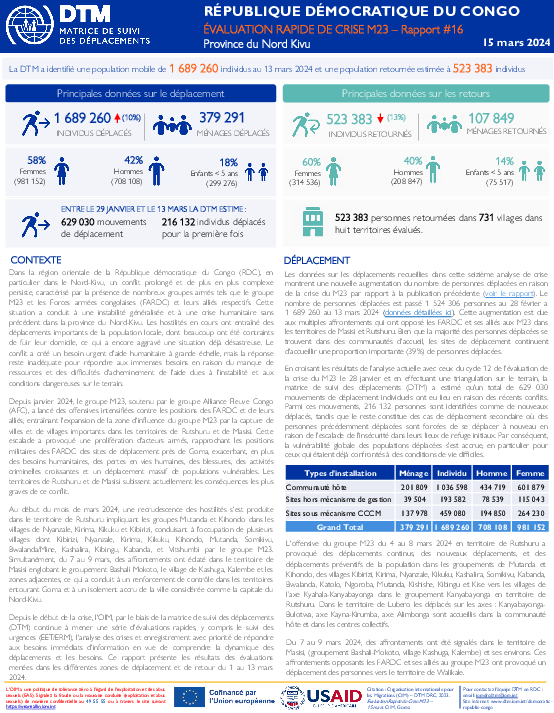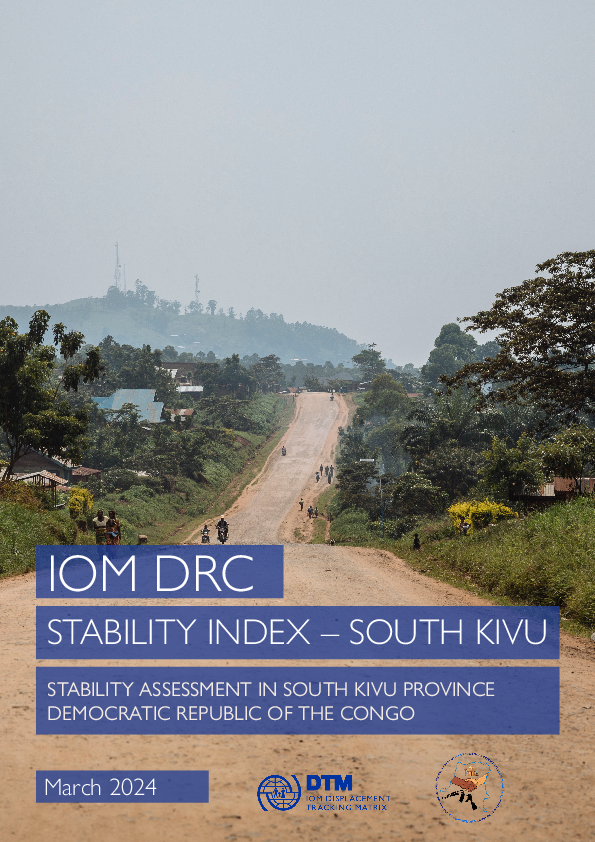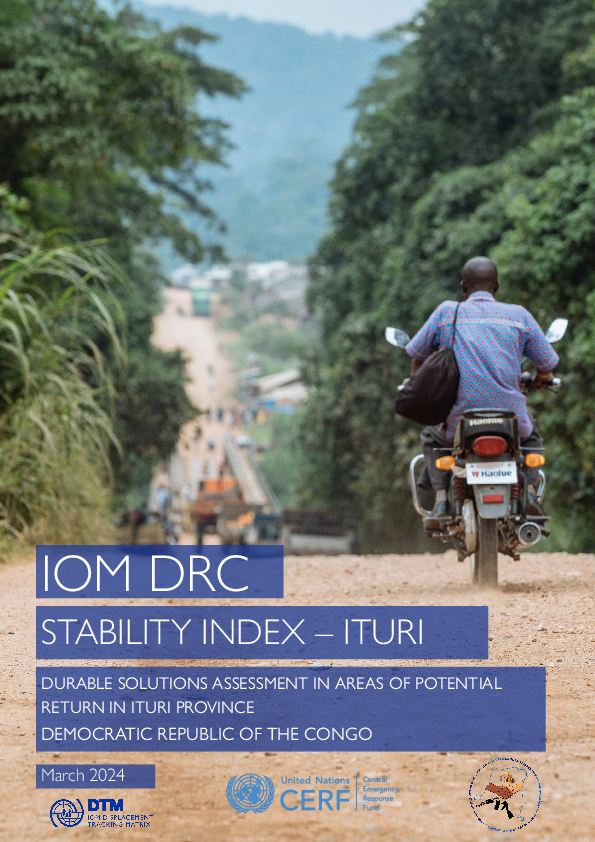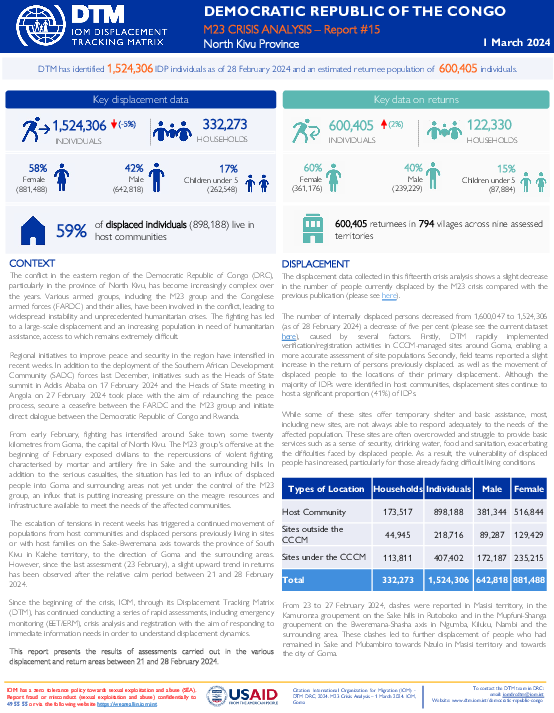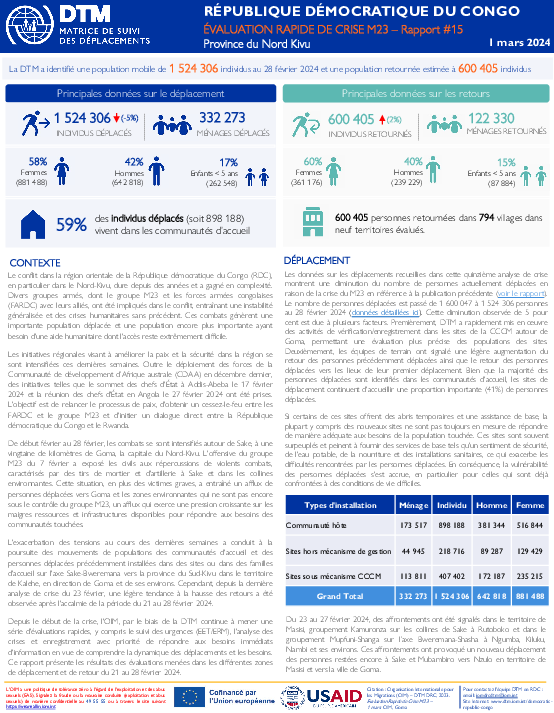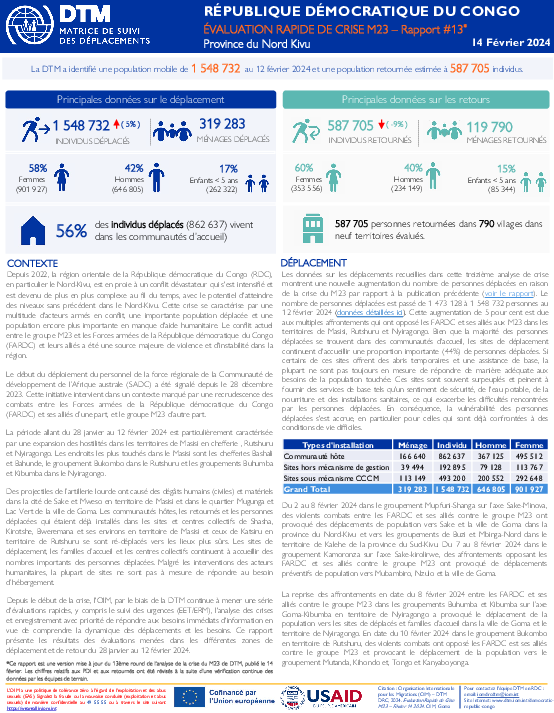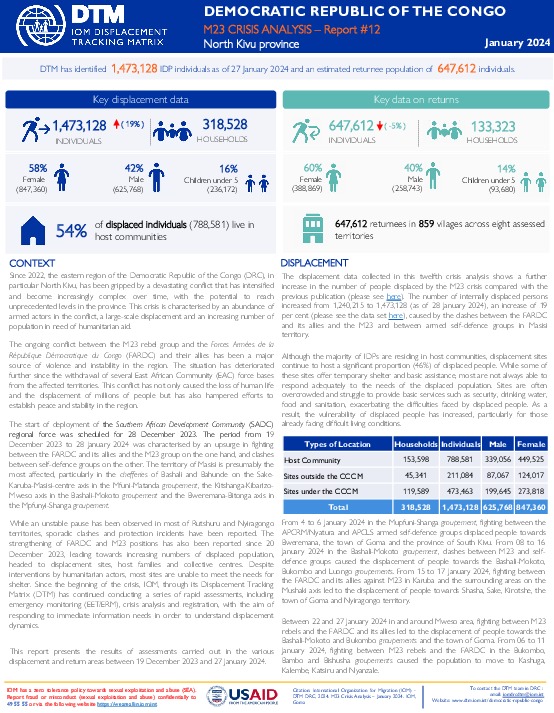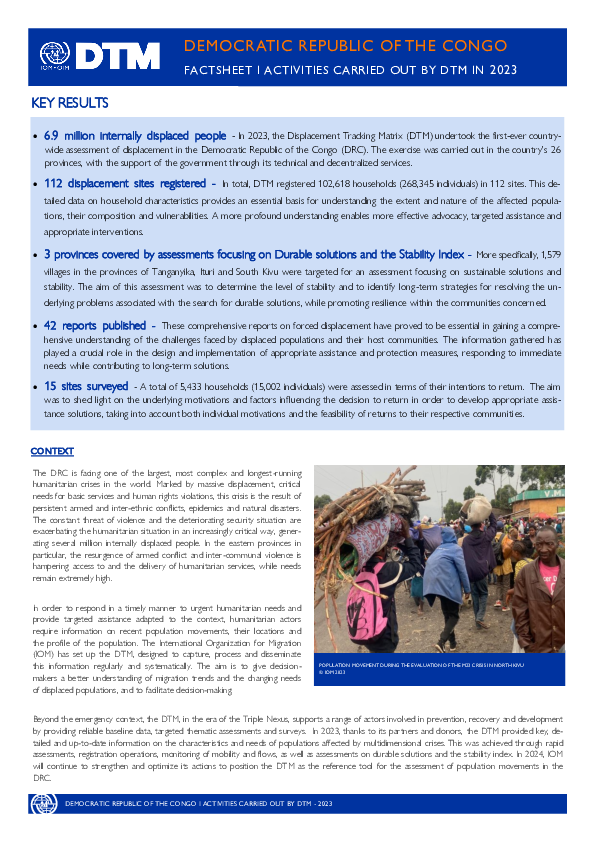-
Countries
-
Data and Analysis
-
Special Focus
-
Crisis Responses
Democratic Republic of the Congo
Democratic Republic of the Congo
Desplazados internos rastreados
Movimientos de desplazamiento
6,734,000
IDMC 2023
Ronda de recopilación de datos
Sobre Democratic Republic of the Congo
The Displacement Tracking Matrix (DTM) is a system to track and monitor the displacement and population mobility. It is designed to regularly and systematically capture, process and disseminate information to provide a better understanding of the movements and evolving needs of displaced populations, whether on site or en route. In the DRC, the DTM was first activated in 2013 in response to the displacement crisis caused by the M23 rebellion in North Kivu. IOM in the Democratic Republic of Congo, using the 4 components of the DTM, collects, analyses and disseminates crucial information on the mobility, vulnerabilities and needs of displaced populations in 9 provinces of the country: North Kivu, South Kivu, Lomami, Kasai, Kasai Oriental, Sankuru, Ituri and Tanganyika. The information collected through the DTM in the DRC allows government and humanitarian actors to provide targeted and context-specific assistance related to mobility.
- Registration: information collected from each displaced person in displacement sites. This information makes it possible to identify displaced persons and to provide targeted assistance to households;
- Surveys: allow IOM to verify information gathered from displaced populations and gather specific information through population sampling, to improve the overall understanding of the beneficiaries;
- Mobility tracking: estimates made periodically about the number of displaced populations and returnees to specific target areas. This allows the various humanitarian actors and decision-makers to have a reliable overview of the scale of displacement and the dynamics of returns.
- Flow monitoring: the tool which IOM uses to assess displaced populations at key entry and transit points along migratory routes commonly used in areas affected by the Ebola Virus epidemic. The objective is to collect information on the origins and destinations of populations in order to anticipate, detect and report potentially dangerous migratory movements that could lead to the spread of Ebola virus disease.
All DTM activities in the Democratic Republic of Congo are implemented in close coordination with specialized Congolese government structures and with the support of national NGOs.
Contacto
DTM Support
iomdrcdtm@iom.int
Current Donors
- Canada (DFATD)
- SIDA
- BHA
- CERF
- USAID
- ECHO
Para obtener resultados de búsqueda más avanzados, vaya a la Página de búsqueda avanzada de informes
RDC — Enquête auprès des utilisateurs de la DTM 2023 (Avril 2024)
L’Organisation Internationale pour les Migrations (OIM) met en œuvre activement sa Matrice de Suivi des Déplacements (DTM) en République Démocratique du Congo (RDC) depuis 2013.
DRC — DTM User Survey 2023 (April 2024)
The International Organization for Migration (IOM) has been actively implementing its Displacement Tracking Matrix (DTM) in the Democratic Republic of the Congo (DRC) since 2013.
Apr 22 2024
DRC — DTM User Survey 2023 (April 2024)
RDC — Nord-Kivu : Rapport d'Enregistrement - Axe Kanyaruchinya (16 Avril 2024)
Le conflit entre les Forces armées de la République démocratique du Congo (FARDC) et le groupe de M23 s’est intensifié depuis mars 2022, entraînant une grave crise humanitaire dans la région.
Apr 16 2024
RDC — Nord-Kivu : Rapport d'Enregistrement -…
DRC — North Kivu : Registration report - Kanyaruchinya Axis (16 April 2024)
The conflict between the Armed Forces of the Democratic Republic of Congo (FARDC) and the M23 group has intensified since March 2022, leading to a serious humanitarian crisis in the region.
DRC — North Kivu: M23 Crisis Analysis (5 April 2024)
In the eastern region of the Democratic Republic of Congo (DRC), particularly in North Kivu province, a prolonged and increasingly complex conflict persists, characterized by the presence of numerous armed groups, including the M23 group and the Congolese Armed Forces (
RDC — Nord Kivu: Évaluation Rapide de Crise M23 (5 Avril 2024)
Dans la région orientale de la République démocratique du Congo (RDC), en particulier au Nord-Kivu, un conflit prolongé et de plus en plus complexe persiste.
DRC — North Kivu: Registration report — (March 2024)
Following the escalation of hostilities between the armed group Mouvement du 23 Mars (M23) and the Congolese Armed Forces (FARDC) and their allies at the end of January 2024, a significant displacement crisis has developed in the eastern region of the Democratic Republi
RDC — Nord-Kivu : Rapport d'Enregistrement — (Mars 2024)
Suite à l’escalade des hostilités entre le groupe armé M23 et les Forces armées congolaises (FARDC) et leurs alliés à la fin du mois de janvier 2024, une importante crise de déplacement s’est développée dans la région orientale de la République démocratique du Congo (RD
Mar 28 2024
RDC — Nord-Kivu : Rapport d'Enregistrement —…
RDC — Nord Kivu: Évaluation Rapide de Crise M23 (15 Mars 2024)
Dans la région orientale de la République démocratique du Congo (RDC), en particulier dans le Nord-Kivu, un conflit prolongé et de plus en plus complexe persiste, caractérisé par la présence de nombreux groupes
DRC — North Kivu: M23 Crisis Analysis (15 March 2024)
In the eastern region of the Democratic Republic of Congo (DRC), particularly in North Kivu, a prolonged and increasingly complex conflict persists, characterized by the presence of numerous armed actors such a
RDC – Indice de stabilité - Sud-Kivu (Mars 2024)
La province du Sud-Kivu abrite la troisième plus grande population de déplacés et de retournés de toutes les provinces de la RDC (1,4 million et 690 mille individus respectivement).
Mar 06 2024
RDC – Indice de stabilité - Sud-Kivu (Mars 2024)
RDC – Indice de stabilité - Ituri (Mars 2024)
La province d’Ituri compte la deuxième plus grande population de PDI et de retournés de toutes les provinces de la RDC (1,6 million et 1,2 million de personnes respectivement) et a fait l’objet d’efforts récents pour renforcer la programmation de solutions durables en RDC.
Mar 06 2024
RDC – Indice de stabilité - Ituri (Mars 2024)
DRC – Stability Index - South Kivu (March 2024)
The province of South Kivu is home to the third largest IDP and returnee population of any province in the DRC (1.4 million and 690 thousand individuals respectively).
Mar 06 2024
DRC – Stability Index - South Kivu (March 2024)
DRC – Stability Index - Ituri (March 2024)
The province of Ituri is home to the second largest IDP and returnee population of any province in the DRC (1.6 million and 1.2 million individuals respectively) and has been in the focus of recent efforts to strengthen durable solutions programming in the DRC.
Mar 06 2024
DRC – Stability Index - Ituri (March 2024)
DRC — North Kivu: M23 Crisis Analysis (1 March 2024)
The conflict in the eastern region of the Democratic Republic of Congo (DRC), particularly in the province of North Kivu, has become increasingly complex over the years.
RDC — Nord Kivu: Évaluation Rapide de Crise M23 (1 Mars 2024)
Le conflit dans la région orientale de la République démocratique du Congo (RDC), en particulier dans le Nord-Kivu, dure depuis des années et a gagné en complexité.
RDC — Nord Kivu: Évaluation Rapide de Crise M23 (23 Février 2024)
Depuis 2022, la région orientale de la République démocratique du Congo (RDC), en particulier le Nord-Kivu, est en proie à un conflit dévastateur qui s'est intensifié et est devenu de plus en plus complexe au fil du temps, avec le potent
DRC — North Kivu: M23 Crisis Analysis (23 February 2024)
Since 2022, the eastern region of the Democratic Republic of Congo (DRC), in particular North Kivu, has been gripped by a devastating conflict that has intensified and become increasingly complex over time, with the potential to reach un
RDC — Nord Kivu: Évaluation Rapide de Crise M23 (14 Février 2024)
Depuis 2022, la région orientale de la République démocratique du Congo (RDC), en particulier le Nord-Kivu, est en proie à un conflit dévastateur qui s'est intensifié et est devenu de plus en plus complexe au fil du temps, avec le potent
DRC — North Kivu: M23 Crisis Analysis (14 February 2024)
Since 2022, the eastern region of the Democratic Republic of Congo (DRC), in particular North Kivu, has been gripped by a devastating conflict that has intensified and become increasingly complex over time, with the potential to reach un
DRC — North Kivu: M23 Crisis Analysis (January 2024)
Since 2022, the eastern region of the Democratic Republic of the Congo (DRC), in particular North Kivu, has been gripped by a devastating conflict that has intensified and become increasingly complex over time, with the potential to reac
RDC — Nord Kivu: Évaluation Rapide de Crise M23 (Janvier 2024)
Depuis 2022, la région orientale de la République démocratique du Congo (RDC), en particulier le Nord-Kivu, est en proie à un conflit dévastateur qui s'est intensifié et est devenu de plus en plus complexe au fil du temps, avec le potent
RDC - Activités menées par la DTM en 2023
La RDC est confrontée à l’une des plus importantes, complexes et longues crises humanitaires au monde.
Jan 16 2024
RDC - Activités menées par la DTM en 2023
DRC – Activities Carried Out by DTM in 2023
The DRC is facing one of the largest, most complex and longest-running humanitarian crises in the world.
Jan 16 2024
DRC – Activities Carried Out by DTM in 2023
Pagination
Para obtener resultados de búsqueda más avanzados, vaya a la Página de búsqueda avanzada de conjuntos de datos
RDC — Nord Kivu: Évaluation Rapide de Crise M23 (November 2022)
2022-11-12
Depuis novembre 2021, les attaques de l’ex-groupe rebelle M23 ont repris et se sont multipliées contre les forces armées congolaises (FARDC) dans l’Est de la RDC. Ces affrontements se sont encore intensifiés depuis mars 2022, à la faveur desquels le M23 s'est emparé en juin 2022 de la ville de…
Baseline Assessment — Tanganyika — Round 14 (Cycle 8)
2022-08-10
A baseline assessment is a sub-component of mobility tracking. It aims to collect data on IDP, migrant or returnee population presence in a defined administrative area of the country.
Baseline Assessment - South Kivu Round 9
2022-07-30
A baseline assessment is a sub-component of mobility tracking. It aims to collect data on IDP, migrant or returnee population presence in a defined administrative area of the country.
Baseline Assessment — Ituri — Round 8
2022-07-25
A baseline assessment is a sub-component of mobility tracking. It aims to collect data on IDP, migrant or returnee population presence in a defined administrative area of the country.
Baseline Assessment — Tanganyika — Round 13 (Cycle 7)
2022-05-06
A baseline assessment is a sub-component of mobility tracking. It aims to collect data on IDP, migrant or returnee population presence in a defined administrative area of the country.
Baseline Assessment — Nord Kivu — Round 42 (Cycle 7)
2022-05-05
A baseline assessment is a sub-component of mobility tracking. It aims to collect data on IDP, migrant or returnee population presence in a defined administrative area of the country.
Baseline Assessment — Ituri — Round 7
2022-04-25
A baseline assessment is a sub-component of mobility tracking. It aims to collect data on IDP, migrant or returnee population presence in a defined administrative area of the country.
Baseline Assessment - South Kivu Round 8
2022-04-18
A baseline assessment is a sub-component of mobility tracking. It aims to collect data on IDP, migrant or returnee population presence in a defined administrative area of the country.
Baseline Assessment — Tanganyika — Round 12 (Cycle 6)
2021-09-01
A baseline assessment is a sub-component of mobility tracking. It aims to collect data on IDP, migrant or returnee population presence in a defined administrative area of the country.
Baseline Assessment - South Kivu Round 7
2021-08-29
A baseline assessment is a sub-component of mobility tracking. It aims to collect data on IDP, migrant or returnee population presence in a defined administrative area of the country.
Baseline Assessment — Ituri — Round 6
2021-08-23
A baseline assessment is a sub-component of mobility tracking. It aims to collect data on IDP, migrant or returnee population presence in a defined administrative area of the country.
Baseline Assessment — Tanganyika — Round 11 (Cycle 5)
2021-05-12
A baseline assessment is a sub-component of mobility tracking. It aims to collect data on IDP, migrant or returnee population presence in a defined administrative area of the country.
Baseline Assessment — Nord Kivu — Round 41 (Cycle 6)
2021-04-20
A baseline assessment is a sub-component of mobility tracking. It aims to collect data on IDP, migrant or returnee population presence in a defined administrative area of the country.
Baseline Assessment — Ituri — Round 5
2021-04-12
A baseline assessment is a sub-component of mobility tracking. It aims to collect data on IDP, migrant or returnee population presence in a defined administrative area of the country.
Baseline Assessment - South Kivu Round 6
2021-04-09
A baseline assessment is a sub-component of mobility tracking. It aims to collect data on IDP, migrant or returnee population presence in a defined administrative area of the country.
Baseline Assessment — Tanganyika — Round 10 (Cycle 4)
2020-12-31
A baseline assessment is a sub-component of mobility tracking. It aims to collect data on IDP, migrant or returnee population presence in a defined administrative area of the country.
Baseline Assessment - Kasai Central - Round 7
2020-12-29
A baseline assessment is a sub-component of mobility tracking. It aims to collect data on IDP, migrant or returnee population presence in a defined administrative area of the country.
Baseline Assessment - South Kivu Round 5
2020-12-14
A baseline assessment is a sub-component of mobility tracking. It aims to collect data on IDP, migrant or returnee population presence in a defined administrative area of the country.
Baseline Assessment — Ituri — Round 4
2020-10-28
A baseline assessment is a sub-component of mobility tracking. It aims to collect data on IDP, migrant or returnee population presence in a defined administrative area of the country.
Baseline Assessment — Ituri — Round 3
2020-03-31
A baseline assessment is a sub-component of mobility tracking. It aims to collect data on IDP, migrant or returnee population presence in a defined administrative area of the country.


